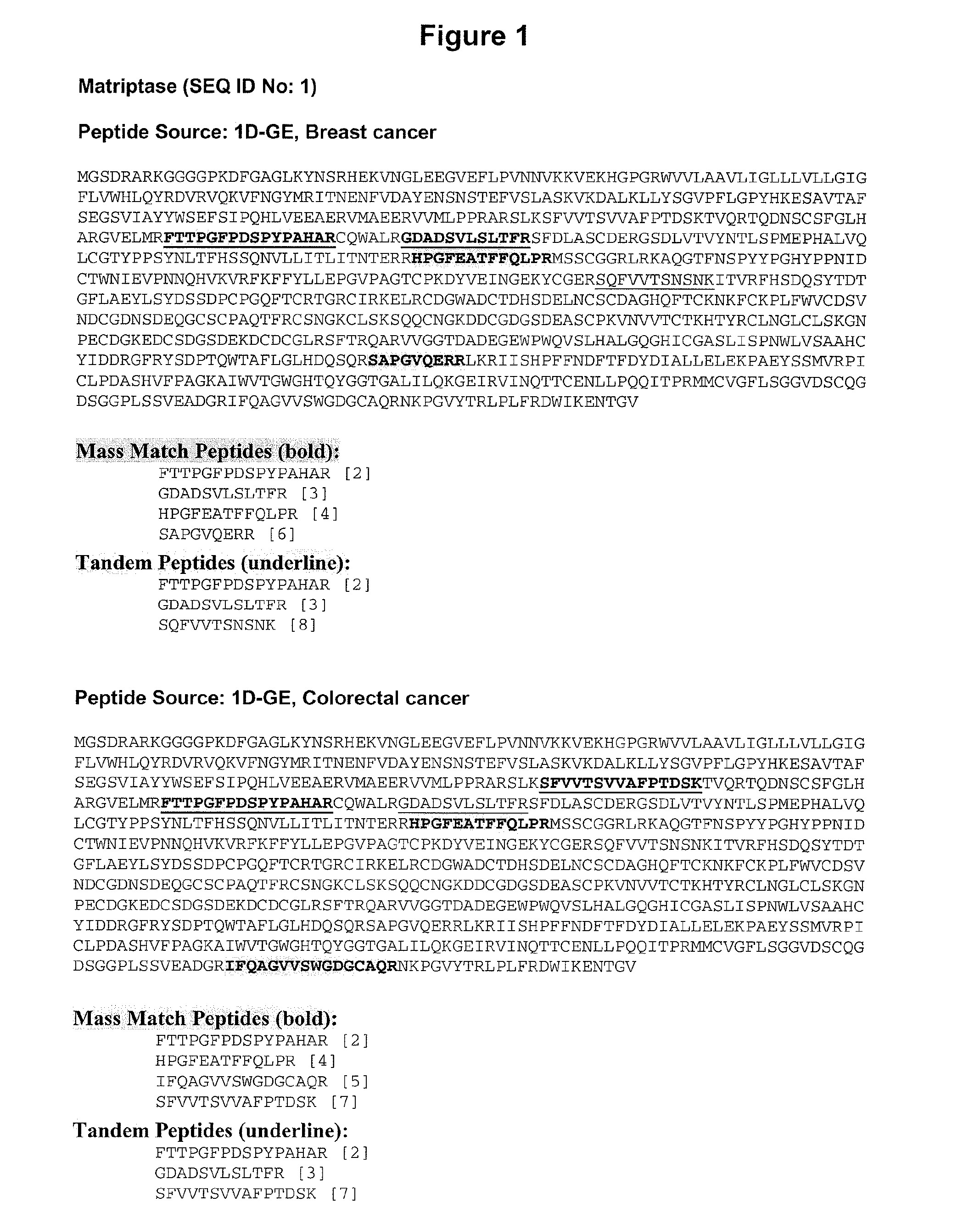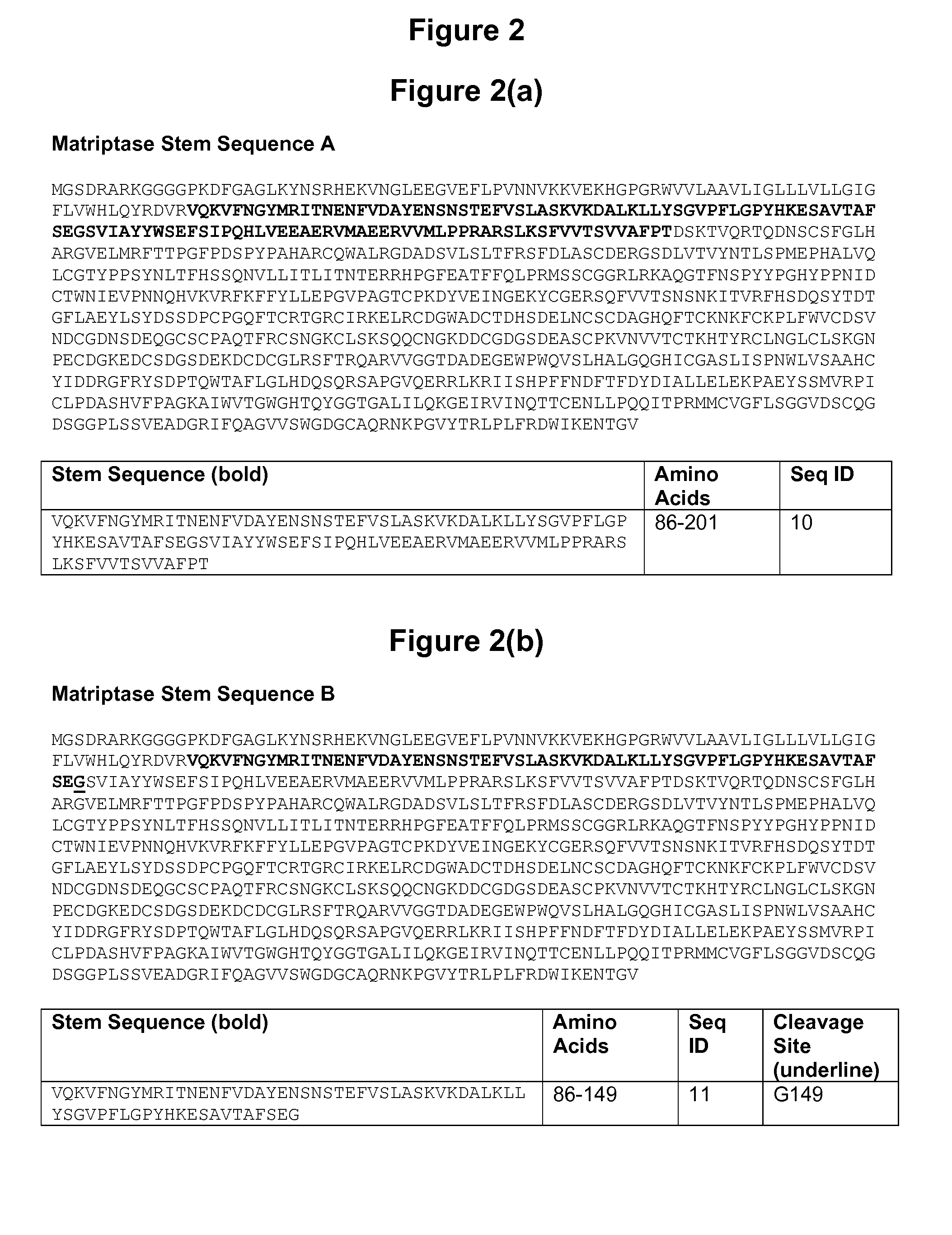Matriptase protein and uses thereof
a technology of matriptase and protein, applied in the field of matriptase protein, can solve the problems of bleeding from surgery, damage to nearby organs, deep veinous thrombosis,
- Summary
- Abstract
- Description
- Claims
- Application Information
AI Technical Summary
Benefits of technology
Problems solved by technology
Method used
Image
Examples
example 1
Identification of Membrane Proteins Expressed in Breast Cancer and Colorectal Cancer Tissue Samples
[0467]Using the following Reference Protocol, membrane proteins extracted from breast cancer and colorectal cancer tissue samples were separated by 1D gel and analysed.
1.1 Materials and Methods
1.1.1—Plasma Membrane Fractionation
[0468]The cells recovered from the epithelium of a breast cancer or colorectal cancer were lysed and submitted to centrifugation at 1000 G. The supernatant was taken, and it was subsequently centrifuged at 3000 G. Once again, the supernatant was taken, and it was then centrifuged at 100,000 G.
[0469]The resulting pellet was recovered and centrifugally fractionated on a 15-60% sucrose gradient.
[0470]A Western blot was used to identify sub cellular markers, and the Plasma Membrane enriched fractions were pooled.
[0471]The pooled solution was either applied directly to 1D gels (see section 1.1.4 below), or further fractionated into heparin binding and nucleotide bind...
example 2
Identification of Membrane Proteins Expressed in Prostate Cancer Tissue Samples
[0501]Using the following Reference Protocol, membrane proteins extracted from prostate cancer tissue samples were analysed using Isotope-Coded Affinity Tags (ICAT).
2.1 Materials and Methods
2.1.1—Preparation of Membrane Fractions
[0502]The cells recovered from a prostate cancer were lysed and submitted to centrifugation at 1000 G. The supernatant was taken, and it was subsequently centrifuged at 3000 G. Once again, the supernatant was taken, and it was then centrifuged at 100 000 G.
[0503]The resulting pellets were dissolved by boiling in labeling buffer (50 mM Tris-HCl pH 8.3, 5 mM EDTA, 0.5% SDS), and the protein concentration was measured.
[0504]A Western blot was used to verify membrane protein markers.
2.1.2—Synthesis of ICAT Reagents
[0505]The ICAT reagents used were synthesized with the following isotopically different substrates: 4,7,10-trioxa-1,13-tridecanediamine (A) (Aldrich, Milwaukee, Wis.) and 2,...
example 3
Generation of Antibodies to the Matriptase Stem
[0510]Using the following Reference Protocol, a matriptase stem Fc-fusion protein was generated and used for immunisation and generation of antibodies to the matriptase stem.
3.1 Materials and Methods
3.1.1—Generation of Matriptase Stem Fc-Fusion Protein
[0511]The full-length matriptase (OGTA004) cDNA was purchased from Open Biosystems, IMAGE ID# 5213189, and was used as a template for amplification. Primers were designed to amplify the stem region spanning amino acids 86-201 and to allow subcloning, in frame, with an N-terminal osteonectin signal sequence, and the C-terminal Factor Xa cleavage site and human FcG1. The insert was subcloned in an Invitrogen pcDNA 3.1 based mammalian expression vector with the hygromycin selectable marker. CHO-S cells were transfected using Invitrogen's DMRIE-C reagent and stable cells were selected under 500 ug / mL of hygromycin B. Expression of the fusion protein was confirmed via Western blot with anti-hum...
PUM
| Property | Measurement | Unit |
|---|---|---|
| molecular weight | aaaaa | aaaaa |
| body weight | aaaaa | aaaaa |
| molecular weight | aaaaa | aaaaa |
Abstract
Description
Claims
Application Information
 Login to View More
Login to View More - R&D
- Intellectual Property
- Life Sciences
- Materials
- Tech Scout
- Unparalleled Data Quality
- Higher Quality Content
- 60% Fewer Hallucinations
Browse by: Latest US Patents, China's latest patents, Technical Efficacy Thesaurus, Application Domain, Technology Topic, Popular Technical Reports.
© 2025 PatSnap. All rights reserved.Legal|Privacy policy|Modern Slavery Act Transparency Statement|Sitemap|About US| Contact US: help@patsnap.com



